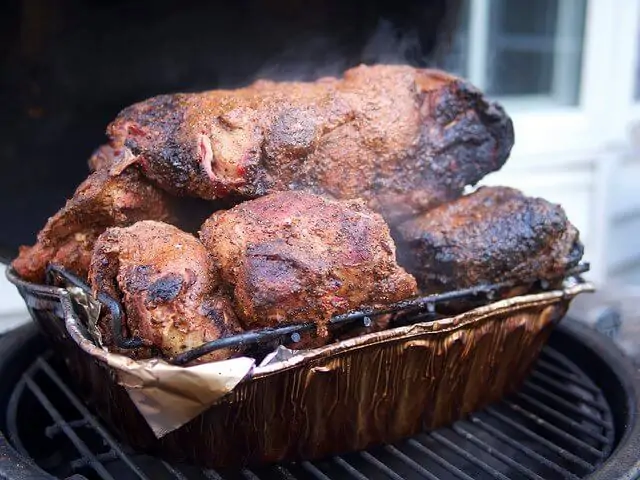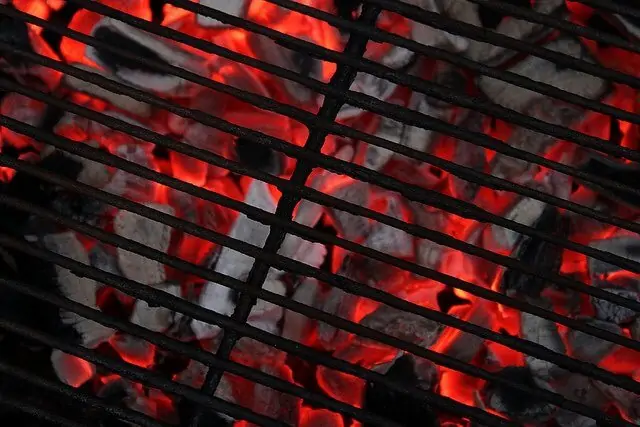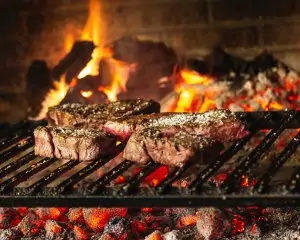
Big Green Egg leads the way when it comes to backyard ceramic grills and smokers.
If you have shelled out the cash to buy one of these little beauties, it stands to reason that you want to fill it with high-quality ingredients.
This isn’t limited to the meat and vegetables you’re cooking up. What about the fuel you use to cook them?
Big Green Egg
This company takes things back to basics and makes a Kamado-style grill that’s as good as it gets.
They believe (and quite rightly so) cooking hasn’t changed a whole lot in the last few thousand years, and that an earthenware enclosure surrounding some burning wood provides for the perfect environment in which to cook.
You don’t just have to take their word for it either! Archaeologists have uncovered evidence of this type of cooking from China to the Mediterranean and beyond.
The Big Green Egg’s iconic domed styling is inspired by an oven first used in China and Japan around seventeen hundred years ago during the Qin Dynasty. Just like today, these centuries old ovens used wood or charcoal.
Unlike those ovens, today’s grills are less likely to cook rice and are usually used to grill and smoke meats. Learn about the best probe thermometers for smoking meat.
Check out the Big Green Egg Cookbook at Amazon.
That’s not to say that you can’t use your Big Green Egg to make some long grained, brown, or simple white rice.
This is your egg and you can do whatever you want!
Lump charcoal versus Briquettes
The removal of moisture and all other volatile constituents from any animal or vegetable substances will create what we know as charcoal.

For cooking purposes, it is pretty safe to assume the charcoal we light will come from wood. Charcoal has been produced for many thousands of years, usually in areas where there was an abundance of wood. It can be made during fine weather, stored in a very dry environment, and then used at a later time to provide a reliable heat source.
Compared to briquettes, lump charcoal lights faster, burns hotter, produces less little ash, allows for easier temperature adjustment, and uses all-natural ingredients. The downside is that it burns faster, is more expensive, and the size of the charcoal is less consistent.
Most BBQ experts swear by lump charcoal, as the natural wood imparts a great flavor.
What makes a good lump charcoal?
- Natural ingredients. High-quality, natural charcoal adds a nice extra flavor. Cheap charcoal produced using a lot of additives and chemicals will add an unpleasant taste to your food.
- Lights fast and burns hot. The charcoal should light quickly and the grill should be ready to go in minutes.
- Long-lasting. The longer the coals burn, the better.
- Size. The size of the lump charcoal you use is important. Cheaper charcoals often have a lot of useless, small crumbs and dust at the bottom of the bag. You also don’t want huge lumps.
Make your own charcoal…
If you have the time and the inclination, you can easily make your own charcoal in your backyard. First, find an empty paint can. (Other cans may work, but paint cans are a little more heavy-duty and can stand up to the heat better). Drill 3 or 4 holes through the lid of the can to let any gases escape—and avoid causing a potential explosion.
The next thing you will want to think about is the type of wood you’re going to use. You can certainly make charcoal whatever wood you have in your yard—maybe those branches from last year—but it’s hard to beat cherry, hickory, or ash if you want to impart a rich flavor to your meat. Just make sure it’s dry.
Break up the wood, fill the paint can, and close it up.
Place the full can on a fire or grill for 4 or 5 hours and wait (feel free to use the time to watch a movie and check your Facebook account). After it’s cooled off, you have your own charcoal!
Remember to practice fire safety whenever you are dealing with open flames!
Or, head to the store!
If you would rather just keep things simple and buy some lump charcoal for your Big Green Egg, I wouldn’t blame you! Let’s take a look at some of the options.
Royal Oak
There’s one charcoal that does the job consistently well. While Big Green Egg does sell their own lump charcoal, it is made by Royal Oak. Their own brand is considerably cheaper, of the same quality, and can be found at any Walmart or online retailer.
Royal Oak lights fast and burns clean. Modestly priced and super effective, it’s hard to beat.
Fogo
Another brand that manufactures lump charcoal suitable for Kamado grills is Fogo. Their Hardwood Lump Charcoal is made from dense Central American Hardwood. This charcoal lights quickly, meaning your grill is ready for use within just 15 minutes.
If you’re environmentally-conscious, Fogo is a good brand to get. It’s produced using sustainable practices from carefully-selected tree trimmings and trees marked for removal.
Conclusion
Royal Oak is the name of the game when it comes to charcoal for your Big Green Egg. If you simply do not agree with Walmart’s politics and prefer not to shop there, Lowes and Home Depot do sell an alternative to Royal Oak called Cowboy Lump. But, Royal Oak’s quality is so much better. As it’s comparably priced, I recommend picking up a bag of the proven brand to smoke/grill your meats.
For more supplies to outfit your grill, read my recommendations on the best pizza peel for the Big Green Egg. You might also like this post on the best pizza stone for Kamado grills.
Need to clean porcelain-coated cast iron grill grates? Read my guide first. Or read here for tips on cleaning stainless steel grates.
Image credit via Flickr Creative Commons: Austin K. and Didriks.
Photo by Gonzalo Guzman from Pexels









Alexis DeAnda is a food fanatic, library card user, and cast iron hunter, in that order. She has been cooking for anyone that will taste it ever since her mom let her make doughnuts on Saturday mornings at the age of 7.